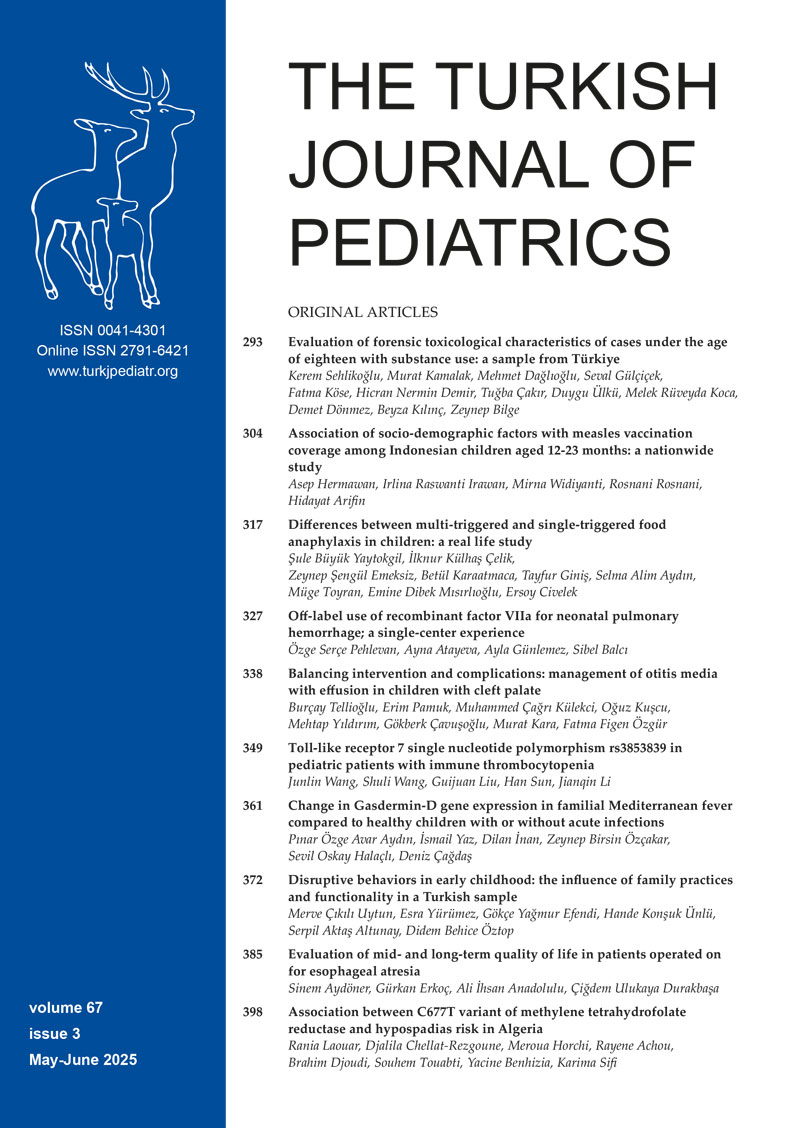Introduction
Dear Editor,
I read with interest the study by Dr. Duan et al.1 titled “The relationship between microRNA- 155-5p and postoperative inflammatory markers in children with acute suppurative appendicitis and its role in predicting postoperative complications” published in The Turkish Journal of Pediatrics. This study makes an important contribution to the field by demonstrating the potential role of miR-155-5p in predicting postoperative complications. The large patient cohort (n=316), the use of advanced techniques such as quantitative polymerase chain reaction (qPCR) and enzyme-linked immunosorbent assay (ELISA), and the comparison of laparoscopic and open appendectomy groups are methodological strengths. The demonstration of correlation between miR-155-5p levels and inflammatory markers and visual analog scale (VAS) score contributes to biomarker-based clinical decision-making. I congratulate the authors for this valuable work. However, I believe some aspects of the study could be further improved.
The follow-up period of postoperative complications, such as wound infection and intraabdominal adhesion were not clearly specified in the study. Furthermore, the lack of late wound healing parameters, such as incisional hernia or scar quality does not fully reflect the impact of surgical techniques on patient comfort.
The study did not address metabolic comorbidities (e.g. obesity, diabetes) or nutritional status, which are known to affect systemic inflammation and surgical outcomes. Childhood obesity increases the risk of postoperative infection, prolongs the duration of surgery and prolongs hospitalization.2 Similarly, low preoperative albumin levels are associated with increased inflammation and complications.3 The exclusion of these factors may limit the assessment of miR-155-5p as an independent variable and reduce the generalizability of the results by ignoring the potential modulation of its expression by chronic conditions. Expanding the study’s comparison between laparoscopic and open appendectomy within a broader framework could also be beneficial. While the VAS score is an effective method for measuring pain severity, the lack of objective parameters such as analgesic consumption limits a comprehensive assessment of patient comfort. Additionally, although the return of gastrointestinal function was measured via ‘time to first flatus,’ other parameters—such as quality of fecal output or time to resume oral intake—could provide further insights. Investigating whether the early postoperative advantages of laparoscopic surgery are linked to miR-155-5p levels could significantly enhance biomarker-based surgical decision-making.
In order to increase the prognostic power of miR-155-5p, comparison with inflammatory markers such as neutrophil-to-lymphocyte ratio (NLR), Systemic Inflammatory Response Index (SIRI) and Systemic Immune-Inflammation Index (SII) may provide a broader clinical perspective. Furthermore, risk prediction can be made more precisely by using machine learning and artificial intelligence-based analyses to create models that predict miR-155-5p levels and the development of postoperative complications.
Finally, in future studies, the molecular mechanisms through which miR-155-5p affects inflammation processes by using mouse appendicitis models or in vitro macrophage cultures may increase the value of the study in terms of translational medicine. This study highlights the importance of biomarker-based approaches in the management of pediatric appendicitis. Further research on molecular mechanisms, long-term follow-up and additional clinical parameters could enhance its impact. I congratulate the authors and the journal for their scientific contribution.
Source of funding
The authors declare the study received no funding.
Conflict of interest
The authors declare that there is no conflict of interest.
References
- Duan C, Lu W, Ma J, Song Y, Zhou L. The relationship between microRNA-155-5p and postoperative inflammatory markers in children with acute suppurative appendicitis and its role in predicting postoperative complications. Turk J Pediatr 2025; 67: 78-89. https://doi.org/10.24953/turkjpediatr.2025.5455
- Davies DA, Yanchar NL. Appendicitis in the obese child. J Pediatr Surg 2007; 42: 857-861. https://doi.org/10.1016/j.jpedsurg.2006.12.040
- Gibbs J, Cull W, Henderson W, Daley J, Hur K, Khuri SF. Preoperative serum albumin level as a predictor of operative mortality and morbidity: results from the National VA Surgical Risk Study. Arch Surg 1999; 134: 36-42. https://doi.org/10.1001/archsurg.134.1.36
Copyright and license
Copyright © 2025 The Author(s). This is an open access article distributed under the Creative Commons Attribution License (CC BY), which permits unrestricted use, distribution, and reproduction in any medium or format, provided the original work is properly cited.















